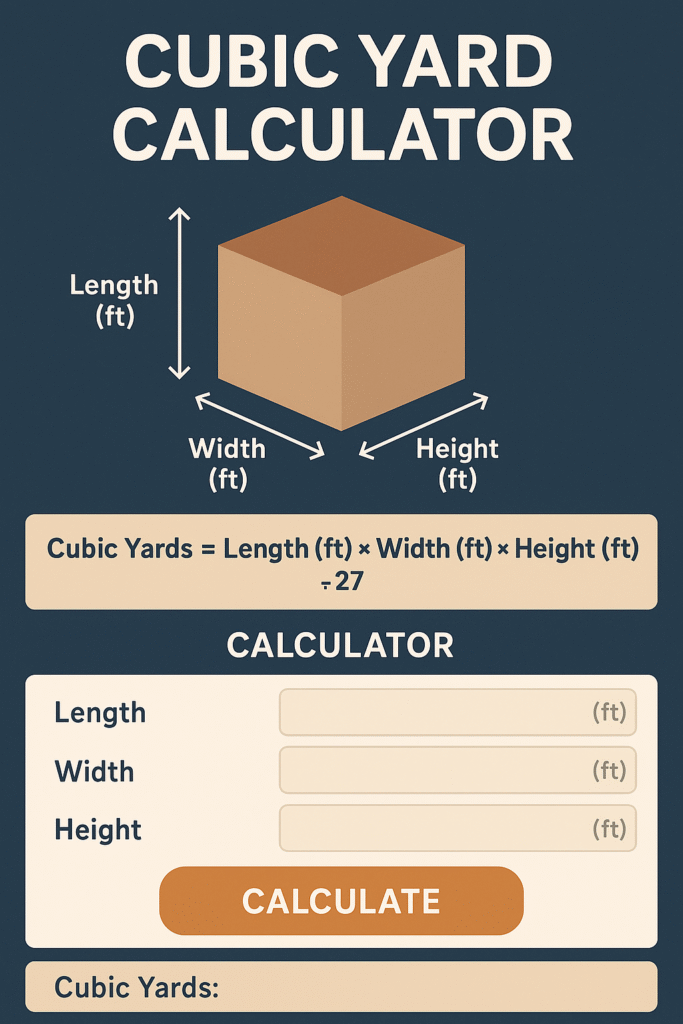Free Cubic Yard Calculator Online
The Cubic Yard Calculator is a crucial tool in construction, landscaping, excavation, energy planning, and sustainable design. Whether you’re estimating soil volume for a school district playground, using Construction Calculators for backfill on a building envelope upgrade, or calculating concrete for an energy-efficient foundation, knowing your cubic yard requirements ensures accurate material planning, cost control, and efficient project timelines. From site lighting trenches to HVAC pad pours, understanding cubic yard needs helps avoid material waste and improve workflow.
Cubic Yard Calculator
What is a Cubic Yard Calculator?
A Cubic Yard Calculator determines the total volume of a space in cubic yards, based on its length, width, and depth. This tool is essential for estimating the quantity of bulk materials like concrete, mulch, gravel, topsoil, or demolition debris. It’s widely used by architects, contractors, energy consultants, and school facility managers to plan material usage across a variety of construction tasks.
In programs like Slipstream or SketchBox™, this calculator complements energy design tools by helping quantify building components, site features, and energy system enclosures. It supports data-driven decisions and accurate assumptions for emissions tracking, resource allocation, and sustainable planning.

Why Cubic Yard Estimation Matters
Everything affects everything in a project’s lifecycle especially when it comes to materials. Misjudging volume can result in overordering, wasted energy in transport, excess emissions, or delays in system installation. Accurately calculating cubic yards ensures you’re using the right amount of material, at the right time, in the right place.
Whether working on a classroom addition in the Snohomish School District or planning underground conduit paths for site lighting in Western Washington, this calculator plays a role in maintaining budget, schedule, and efficiency.
Core Formula for Cubic Yard Calculation
$$Cubic Yards=Length (ft)×Width (ft)×Depth (ft)27\text{Cubic Yards} = \frac{\text{Length (ft)} \times \text{Width (ft)} \times \text{Depth (ft)}}{27}Cubic Yards=27Length (ft)×Width (ft)×Depth (ft)$$
Example
If your project area is 20 feet long, 10 feet wide, and 1.5 feet deep: $$Cubic Yards=20×10×1.527=30027≈11.11 cubic yards\text{Cubic Yards} = \frac{20 \times 10 \times 1.5}{27} = \frac{300}{27} \approx 11.11 \text{ cubic yards}Cubic Yards=2720×10×1.5=27300≈11.11 cubic yards$$
This estimate allows you to plan material delivery, labor scheduling, and equipment usage while reducing waste and emissions.
Benefits of Using a Cubic Yard Calculator
- Accurately estimates material volume for backfill, concrete, soil, and energy system bases
- Supports emissions reduction by eliminating excess trucking and disposal
- Improves material procurement by linking volume directly to project timelines
- Helps school districts and contractors stay within sustainability and budget goals
- Connects to envelope upgrades, underground energy system design, and site prep
- Reduces rework by ensuring right-sized material orders and precise excavation planning
- Integrates with project management tools and energy modeling platforms
- Enhances sustainable design by supporting data-driven volume assumptions
Applications in Real Projects
School District Grounds
Facility teams use the Cubic Yard Calculator to estimate mulch for landscaping, concrete volume for walkways, and backfill for underground lighting or utility pathways—ensuring site readiness for safe student use.
Energy-Efficient Foundations
When working with heat recovery coils, HVAC enclosures, or photovoltaic pads, cubic yard calculations help plan concrete pours or fill volumes with accuracy, supporting both structural safety and emissions compliance.
Building Envelope Work
For trenching, envelope insulation voids, or green roof media, this calculator supports envelope design decisions that influence energy efficiency, heating loads, and air quality management.
How to Use the Cubic Yard Calculator
- Measure Project Dimensions: Get accurate length, width, and depth in feet
- Apply the Formula: Multiply the values and divide the result by 27
- Round Appropriately: Account for compaction, waste factor, or terrain variance
- Input Into Procurement Systems: Use volume for ordering, scheduling, and site planning
- Compare With Other Design Tools: Align with HVAC, lighting, or envelope modeling systems
- Track Performance Metrics: Use results to estimate emissions or transportation energy use
Final Thoughts
The Cubic Yard Calculator is more than a simple math tool — it’s a powerful asset for sustainable planning, real-time energy connections, and construction efficiency. By turning basic dimensions into material data, it helps architects, contractors, and project managers prevent overuse, reduce emissions, and stay on schedule. Tools like the Conversion Calculator, Fire Resistance Rating Calculator, and Building Occupancy Calculator further support accurate planning and code-compliant decision-making.
Whether you’re filling envelope cavities, pouring slabs for HVAC systems, or designing schoolyard layouts, cubic yard accuracy supports better decisions at every level of the project. Use it early, use it often, and keep your planning grounded in numbers that support sustainability and performance.
